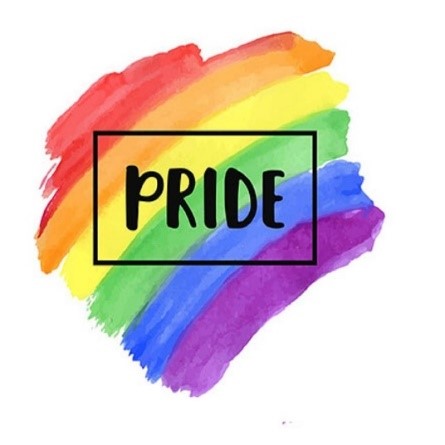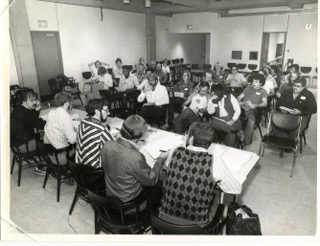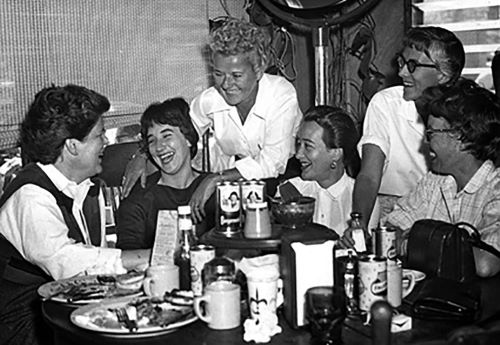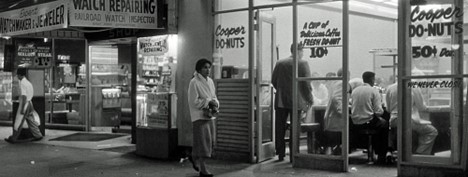
As we celebrate Pride month, UCOH presents part 3 of a 4-week blog post series by author and UCOH Rainbow Ambassador Charles Davis. Charles presents the evolution of attitudes regarding LGBTQIA+ individuals and early attempts to achieve equality. Read on…
The Stonewall Inn and the Beginning of the Modern Equality Movement, Part 3
By Charles Davis, UCOH Rainbow Ambassador
Unity Principle # 3: We are co-creators with God, creating reality through thoughts held in mind.
The Twentieth Century was a time of great advances culturally and technologically in our world, but in our desire for more possessions and greater power, we saw our neighbors as “different” and a threat to our well-being. In our fear and distrust, we created exactly the world we envisioned. This led to two world wars and countless other smaller wars and conflicts, causing pain and suffering on many levels.
However, the 20th century also held the beginnings of change in our society, of awakening to the Truth of our existence. In this, the third installment of our Pride series, we will consider the events in America leading up to the uprising at the Stonewall Inn in Greenwich Village, New York, on June 28, 1969.
The pilgrims coming to America formed a society based upon the Puritan values of a traditional heterosexual family structure (one man, one woman). This, of course, led to criminalization of homosexuality, or sodomy, which they saw as a threat to those values.

The Queer community (this is a term commonly embraced by the LGBTQIA+ community today) has led a shadow life for most of the 20th century, existing on the outskirts of society. They were left alone as long as they stayed out of view and kept to themselves. Periodically, individuals were singled out for punishment to show that the authorities were “cleaning up” the neighborhoods, making them safe for “normal” families. For much of the time, the Queer community bought into this treatment, feeling that as long as they hid their true nature, they would be okay.
However, there were clear signs of change. The 50’s and 60’s saw a drastic shift from our parents’ way of thinking to a new prosperous future America had created coming out of World War II. The “sexual revolution” was taking over our society. Women were claiming their proper positions in society and were no longer content with just “taking care of the house and kids”. They took their places alongside men in board rooms across the country. Taking heart from the advancement in Women’s equality, the queer culture began standing up for themselves also, no longer willing to be shoved into the corners of society.
With the “sexual revolution”, came thought that perhaps humanity was not strictly heterosexual or homosexual, but rather a continuous gradient between the two. The first to advance this concept clinically was biologist and sex researcher Alfred Kinsey who, in 1948, created the seven-point Kinsey Scale to categorize humanity along this gradient.
This was groundbreaking thought at the time and generated a great deal of conversation amongst the psychiatric community, but the American Psychiatric Association (APA) still classified the term “homosexuality” (as used at that time) as a “sexual deviation” within the larger “sociopathic personality disturbance”. This, of course, gave fodder for the general public to continue marginalizing the queer community in America as they had their entire lives. Almost as soon as this APA categorization became public, however, a cross-section of professionals in medicine, mental health and social science disciplines began to criticize that decision.
Four years later, American psychologist Evelyn Hooker published “The Adjustment of the Male Overt Homosexual”, concluding that homosexuality was not a clinical entity and that homosexuals and heterosexuals did not actually differ that significantly from each other. This paper began to change clinical perceptions of LGBTQIA+ people. Unfortunately, it wasn’t for another 17 years before the APA finally voted to remove “homosexuality” from its list of mental illnesses in 1973.
The 1950’s were particularly hard on LGBTQIA+ people. In addition to being designated a “sociopathic personality disorder” by the APA, they were banned from working at any federal government agencies or their contractors, because they were considered “security risks.” Non-governmental employers followed suit and many LGBTQIA+ people lost their livelihood when they were inadvertently “outed”.

However, it wasn’t all bad. Due to the efforts of early activists along with the changing opinions of some in the psychiatric profession, advances were made. In 1962, Illinois became the first state to decriminalize same-sex activity.
The earliest organization to work on behalf of the LGBTQIA+ community in America was the Society for Human Rights, but that organization disbanded almost immediately due to societal and governmental pressure. It wasn’t until 1950 that the Mattachine Society was founded by Harry Hay, becoming the first sustained organization working for the equality of the queer community in America.

Soon thereafter, The Daughters of Bilitis was formed in San Francisco, becoming the first lesbian organization.

In addition to organizations working within the governmental structure to advance equality for the queer community, civil unrest played its own part. The Stonewall Riots were not the first of such events to occur in our history.
Ten years prior to Stonewall, an uprising occurred in Los Angeles at Cooper Donuts, a shop catering to queer clients due to its proximity to several bars in the area. The night of the riot, police raided the establishment, ultimately leading five individuals out of the shop and attempting to shove them into a single police car. When one of the men protested being manhandled, it incited a riot with people in the area pelting the officers with donuts, paper plates, coffee cups and anything else they could get their hands on.

Of course, civil disobedience was not always violent. On New Year’s Eve 1966, police raided The Black Cat Tavern in Los Angeles, beating several queer patrons for exchanging same-sex kisses at midnight. No riot ensued, but in the weeks following the raid, the “Personal Rights in Defense and Education” (PRIDE) was formed in the community. The next year, 200 demonstrators gathered peacefully outside The Black Cat, to give speeches and hand out leaflets to passersby. Despite large numbers of police dispatched to the location that day, the protestors remained calm, refusing to give the police a reason to retaliate against them.

In our next installment, we will consider the events of June 28, 1969 at the Stonewall Inn, along with everything that has happened since that day to advance equality for LGBTQIA+ people.
[Note on language: Language is fluid and ever evolving. Terminology and usages change from era to era, culture to culture, and even person to person. While we have endeavored to use terminology that is respectful to the individuals and communities mentioned in this series, some of the language may be considered offensive or problematic today or in the future. For example, the use of “queer” in this article. This term was, in the days of Stonewall, an unpleasant slur that was thrown in our faces to embarrass and demean us. Today, this word has been reclaimed by the LGBTQIA+ community as an umbrella term to mean anyone who is not exclusively heterosexual. For some younger people, the terms lesbian, gay and bisexual are too limiting or have cultural connotations that do not apply to them (https://www.them.us/video/watch/what-does-queer-mean-inquiry ). When trying to decide what language to use, it is important to follow the lead of individuals and communities, listening to current best practices. GLAAD’s Media Reference Guide (https://www.glaad.org/reference/terms ) is a great resource for this. We welcome feedback, comments, questions, and constructive criticism, so if you see anything that could use updating, please let the author know and we will take your concerns into consideration. Contact: Charles Davis, cdavis114@icloud.com]